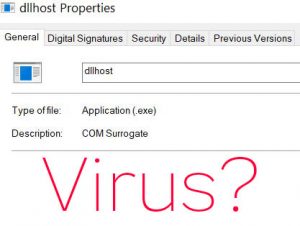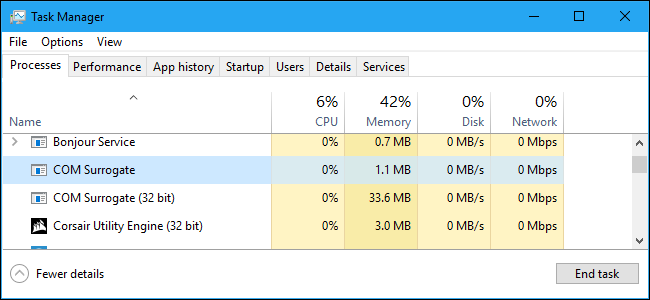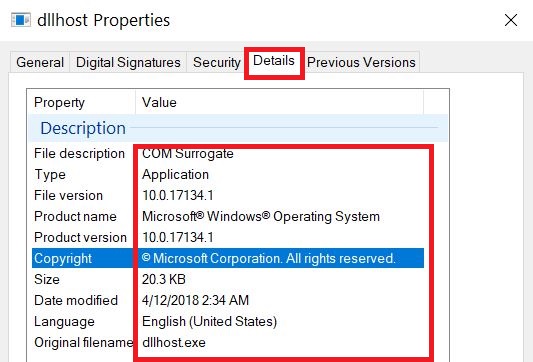 What is COM Surrogate? How to remove it from your computer? IS COM Surrogate a virus or legitimate?
What is COM Surrogate? How to remove it from your computer? IS COM Surrogate a virus or legitimate?
The COM Surrogate is the name of a legitimate Windows 10 process that is often imitated by iruses and this is why it should be checked before you decide to trust it. Users could locate this process in Windows Task Manager. Having COM Surrogate running in the background does not necessarily mean that your computer has been infected, but usually, some viruses use fake COM Surrogate names as a way to hide themselves from antivirus software. If you see COM Surrogate running on your computer, read this article to learn how to remove it if a virus.

Threat Summary
| Name | COM Surrogate virus |
| Type | Windows Process or a Virus |
| Short Description | The COM Surrogate (also known as dllhost.exe) may be legitimate Windows proces sor a virus. |
| Symptoms | One or more COM Surrogate processes running actively In your task manager. |
| Distribution Method | If a virus, could be spread via malicious web links or files that pretend to be legitimate. |
| Detection Tool |
See If Your System Has Been Affected by malware
Download
Malware Removal Tool
|
User Experience | Join Our Forum to Discuss COM Surrogate virus. |

COM Surrogate – How Did I Get It and What Does It Do?
COM Surrogate can be easily recognised in Windows task manager:
One way to check if COM Surrogate is not a virus is to see it’s properties by right-clicking on the process:
Then, you should see a tab, called Details. In this tab, you can check if the file is digitally signed by Microsoft. Below, you can see how a legitimate COM Surrogate file should look like:
But be aware, because this check is not 100% guarantee that your computer is safe from COM Surrogate. Some viruses, like Trojans, Spyware, Infostealers, RATs and other malware could inject malicious code into COM Surrogate and make it seem like a completely legitimate file. If you notice unusual behaviour on your computer, heightened network activity and tens of COM Surrogate processes running, you should check your computer for malware.
If malware, COM Surrogate – related viruses may have infected your computer as a result of the following methods:
- Via a malicious link opened on your browser.
- Via a file, downloaded and ran on your computer.
Once infected your PC, depending on the virus type it is, a virus using COM Surrogate to hide can perform a range of activities in it, like:
- Logging your keystrokes.
- Display ads.
- Collect passwords you have saved.
- Log the keystrokes you type.
- Obtain data from your network activity.
- Take screenshots.
- Tap into your camera or microphone.
Either way, if you notice any unusual activity, we do recommend that you check your computer for malware by using the instructions below.

Removal Instructions for COM Surrogate Viruses
To remove a virus using COM Surrogate by yourself, you can try steps 1 and 2 from the instructions below. Be advised however, that the most effective way to know if your computer has been compromised by COM Surrogate is to run a scan of It, by using a professional anti-malware software. Such program will scan your computer for all forms of Spyware and other malware and remove them effectively without damaging Windows.
Preparation before removing COM Surrogate virus.
Before starting the actual removal process, we recommend that you do the following preparation steps.
- Make sure you have these instructions always open and in front of your eyes.
- Do a backup of all of your files, even if they could be damaged. You should back up your data with a cloud backup solution and insure your files against any type of loss, even from the most severe threats.
- Be patient as this could take a while.
- Scan for Malware
- Fix Registries
- Remove Virus Files
Step 1: Scan for COM Surrogate virus with SpyHunter Anti-Malware Tool



Step 2: Clean any registries, created by COM Surrogate virus on your computer.
The usually targeted registries of Windows machines are the following:
- HKEY_LOCAL_MACHINE\Software\Microsoft\Windows\CurrentVersion\Run
- HKEY_CURRENT_USER\Software\Microsoft\Windows\CurrentVersion\Run
- HKEY_LOCAL_MACHINE\Software\Microsoft\Windows\CurrentVersion\RunOnce
- HKEY_CURRENT_USER\Software\Microsoft\Windows\CurrentVersion\RunOnce
You can access them by opening the Windows registry editor and deleting any values, created by COM Surrogate virus there. This can happen by following the steps underneath:


 Tip: To find a virus-created value, you can right-click on it and click "Modify" to see which file it is set to run. If this is the virus file location, remove the value.
Tip: To find a virus-created value, you can right-click on it and click "Modify" to see which file it is set to run. If this is the virus file location, remove the value.Step 3: Find virus files created by COM Surrogate virus on your PC.
1.For Windows 8, 8.1 and 10.
For Newer Windows Operating Systems
1: On your keyboard press + R and write explorer.exe in the Run text box and then click on the Ok button.

2: Click on your PC from the quick access bar. This is usually an icon with a monitor and its name is either “My Computer”, “My PC” or “This PC” or whatever you have named it.

3: Navigate to the search box in the top-right of your PC's screen and type “fileextension:” and after which type the file extension. If you are looking for malicious executables, an example may be "fileextension:exe". After doing that, leave a space and type the file name you believe the malware has created. Here is how it may appear if your file has been found:

N.B. We recommend to wait for the green loading bar in the navigation box to fill up in case the PC is looking for the file and hasn't found it yet.
2.For Windows XP, Vista, and 7.
For Older Windows Operating Systems
In older Windows OS's the conventional approach should be the effective one:
1: Click on the Start Menu icon (usually on your bottom-left) and then choose the Search preference.

2: After the search window appears, choose More Advanced Options from the search assistant box. Another way is by clicking on All Files and Folders.

3: After that type the name of the file you are looking for and click on the Search button. This might take some time after which results will appear. If you have found the malicious file, you may copy or open its location by right-clicking on it.
Now you should be able to discover any file on Windows as long as it is on your hard drive and is not concealed via special software.
COM Surrogate virus FAQ
What Does COM Surrogate virus Trojan Do?
The COM Surrogate virus Trojan is a malicious computer program designed to disrupt, damage, or gain unauthorized access to a computer system. It can be used to steal sensitive data, gain control over a system, or launch other malicious activities.
Can Trojans Steal Passwords?
Yes, Trojans, like COM Surrogate virus, can steal passwords. These malicious programs are designed to gain access to a user's computer, spy on victims and steal sensitive information such as banking details and passwords.
Can COM Surrogate virus Trojan Hide Itself?
Yes, it can. A Trojan can use various techniques to mask itself, including rootkits, encryption, and obfuscation, to hide from security scanners and evade detection.
Can a Trojan be Removed by Factory Reset?
Yes, a Trojan can be removed by factory resetting your device. This is because it will restore the device to its original state, eliminating any malicious software that may have been installed. Bear in mind that there are more sophisticated Trojans that leave backdoors and reinfect even after a factory reset.
Can COM Surrogate virus Trojan Infect WiFi?
Yes, it is possible for a Trojan to infect WiFi networks. When a user connects to the infected network, the Trojan can spread to other connected devices and can access sensitive information on the network.
Can Trojans Be Deleted?
Yes, Trojans can be deleted. This is typically done by running a powerful anti-virus or anti-malware program that is designed to detect and remove malicious files. In some cases, manual deletion of the Trojan may also be necessary.
Can Trojans Steal Files?
Yes, Trojans can steal files if they are installed on a computer. This is done by allowing the malware author or user to gain access to the computer and then steal the files stored on it.
Which Anti-Malware Can Remove Trojans?
Anti-malware programs such as SpyHunter are capable of scanning for and removing Trojans from your computer. It is important to keep your anti-malware up to date and regularly scan your system for any malicious software.
Can Trojans Infect USB?
Yes, Trojans can infect USB devices. USB Trojans typically spread through malicious files downloaded from the internet or shared via email, allowing the hacker to gain access to a user's confidential data.
About the COM Surrogate virus Research
The content we publish on SensorsTechForum.com, this COM Surrogate virus how-to removal guide included, is the outcome of extensive research, hard work and our team’s devotion to help you remove the specific trojan problem.
How did we conduct the research on COM Surrogate virus?
Please note that our research is based on an independent investigation. We are in contact with independent security researchers, thanks to which we receive daily updates on the latest malware definitions, including the various types of trojans (backdoor, downloader, infostealer, ransom, etc.)
Furthermore, the research behind the COM Surrogate virus threat is backed with VirusTotal.
To better understand the threat posed by trojans, please refer to the following articles which provide knowledgeable details.





